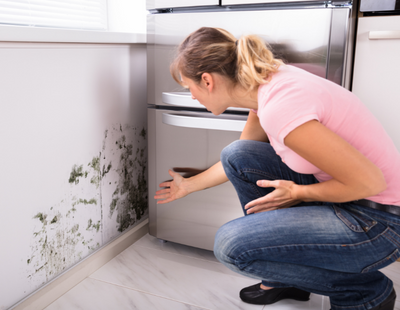New directives issued by the government put the emphasis firmly on private landlords and their letting agents to take responsibility for issues of damp and mould in their rental properties.
The guidance puts private landlords and agents on a par with housing associations and councils in facing unlimited penalties if they ignore damp and mould problems.
Housing Secretary Michael Gove says: “Damp and mould in the home are not the result of ‘lifestyle choices’, and it is the responsibility of landlords to identify and address the underlying causes of the problem, such as structural issues or inadequate ventilation.”
The guidance - from Gove’s Department for Levelling Up, Housing and Communities, as well as the Department of Health and Social Care - tells agents and private landlords to familiarise themselves with four key points.
-
All homes must be free from hazards at the most dangerous ‘category 1’ level
The Housing Act 2004 states that properties must be free from hazards at the most dangerous ‘category 1’ level, as assessed using the Housing Health and Safety Rating System (HHSRS), a risk-based evaluation tool. This includes mould and all types of dampness.
Generally, a ‘category 1’ hazard means that an occupier of or visitor to the property may require some form of medical attention over the course of a year. Local councils also have a power to take action when they identify hazards at the ‘category 2’ level.
-
All homes must not contain conditions that are prejudicial to health
The Environmental Protection Act 1990 gives tenants and local councils powers to take legal action where homes contain a ‘statutory nuisance’, which includes where they are in such a state as to be prejudicial to health.
To be a statutory nuisance, the damp and mould must be harmful to the health of the tenant or a nuisance.
-
Homes must be fit to live in
New provisions in the Landlord and Tenant Act 1985 added by the Homes (Fitness for Human Habitation) Act 2018 require that properties are free of hazards, including damp and mould, which are so serious that the dwelling is not reasonably suitable for occupation in that condition. The current occupier may be taken into consideration when determining whether the property is suitable.
A home that is fit for human habitation is safe and healthy, which would mean free from damp and mould that could cause significant harm.
Tenants may wish to take action if their property is unfit for human habitation or the landlord has failed to keep it in repair, under defined circumstances, under Section 9A and Section 11 of the Landlord and Tenant Act 1985. While there is currently no legal requirement to undertake remedial work within a specific period of time, landlords should nonetheless respond to complaints about repairs promptly.
-
And Privately rented homes must meet minimum energy efficiency standards
The Energy Efficiency (Private Rented Property) (England and Wales) Regulations 2015 require that privately rented homes must meet the Minimum Level of Energy Efficiency standard of Energy Performance Certificate (EPC) band E (unless exempt). The regulations do not make reference to damp and mould, but an energy efficient property is less likely to be affected by condensation, one cause of damp and mould, provided it is adequately ventilated.
In addition to all this the Renters Reform Bill will introduce ways to oversee agents’ and private landlords’ handling of mould and damp.
The Housing Ombudsman will address tenant complaints when agents and landlords fail to act, and the Property Portal will document Agent and landlord compliance with the Decent Homes Standards, among other rules.
Here is the guidance in full.





.jpg)







%20-%20IMAGE%20Client%20Accounting%20%E2%80%93%20what%20are%20your%20options.jpg)

%20(002).png)
.png)
.png)





Join the conversation
Jump to latest comment and add your reply
We've had our electrican install Nuaire Drimaster 'Heat' Positive Input Ventilation (PIV) units in all of our rental houses and flats. Our Building Manager has a rolling calendar reminder to change the filters every 3 years (Nuaire states the filters last 5 years but from our testing this is incorrect).
We have fitted locked covers over the ON/OFF switches so our tenants cannot accidently turn off the PIV units. The 'dementia proof' switch covers are from a great company called Security Safety Products. Tenants are now delighted and they washing and bathroom towels dry within hours, no condensation on the windows and no damp/mould in the corners of rooms/backs of wardrobes.
Simple, low-cost PIV mechanical ventilation is the fit-and-forget solution to damp and mould. It's not rocket science.
I considered one of the Nuaire units for my own house but decided against it because it would introduce a constant input of cold possibly damp air. The model with a heater would be expensive to run. I opted instead for giving the house a good hour of opening windows to ventilate and longer in the kitchen and bathroom. I don’t put damp clothes on radiators.
Gove refers to identifying structural and ventilation problems. Structural, fair enough these should be addressed but inadequate ventilation is still very much down to common sense and lifestyle. If a tenant refuses to behave sensibly in respect of ventilation and condensation problems then I will accept installing one of these PIV units but I would ask them not to complain to be about their increased energy bills.
No tenants should have to live in damp and mouldy conditions..
Landlords are fast to take the rent and for many that's about it and as for power companies if there is anything that landlords are supposed to do then they should.
?
I agree - therefore tenants should ensure that they ventilate houses every day by opening windows & adequately heat the property they are in - this will stop them causing condensation on external walls & windows which causes mould to grow.
I do not understand why the idiot Gove thinks that mould caused by tenants actions has to be remedied by landlords - maybe he should consider educating tenants????
Not only is Gove a fool but he likes to prove it regularly!!!!
Colin Harrison
11 September 2023 10:46 AM
Not only is Gove a fool but he likes to prove it regularly!!!!
And too often.
As all good agents & landlords know- there is a vast difference between mould from damp and mould from condensation. Damp, is a building fabric issue and therefore addressing any issues resulting from the SHOULD be the responsibility of the landlord (or freeholder) or their agent. However, mould caused by condensation through poor use of the property and inadequate ventilation, temperature maintenance, etc. is and should be the tenants' liability/responsibility. Proving which is which is not often so easy to do!
Gove confirms what a fool he is with every misguided utterance
i've had tenants dry clothes on radiators on a dry and windy day having taped up the ventilation fan and closed the windows. We all have to have a sufficient EPC rating, cutting out the draughts especially in prewar houses built to use the fresh air flow fron open or gas fires. Instead of issuing dictats which promote a catch 22 situation, perhaps Mr.Gove should try to run rentals himself and then the Bazalgette (parliament sewer stink) may take effect.
Please login to comment